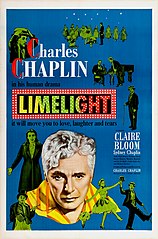Światła rampy
Światła rampy (oryg. Limelight) – amerykański czarno-biały komediodramat z 1952 roku w reżyserii Charlesa Chaplina. Stanowi on pożegnanie z jego słynną postacią Trampa[1]. Chaplin zaprosił do współpracy swego odwiecznego rywala Bustera Keatona, który zagrał partnera Calvero[1].
Fabuła
Akcja filmu toczy się w Londynie. Calvero, zapomniany komik, ratuje młodą kobietę, Therezę, która podejmuje samobójczą próbę przez odkręcenie gazu. Wcześniej była baletnicą, ale przerwała karierę gdy dostała gorączki reumatycznej i sparaliżowania nóg z powodu przeżycia, jakim było zobaczenie siostry jako ulicznicy. Calvero pomaga Therezie wyjść z choroby i stać się wielką gwiazdą. Sam również dostaje angaż do tego samego baletu, co kobieta i wydaje się, że odzyskuje dawną sławę. Jednak w trakcie późniejszego kabaretowego występu niefortunnie spada ze sceny i umiera.
Obsada
- Charles Chaplin – Calvero
- Claire Bloom – Thereza
- Buster Keaton – partner Calvera
- Sydney Chaplin – Neville
- Norman Lloyd – Bodalink
- Wheeler Dryden – doktor Therezy
- Barry Bernard – John Redfern
- Stapleton Kent – Claudius
- Mollie Glessing – pokojówka
- Leonard Mudie – doktor Blake
Przypisy
- ↑ a b Paula Apanowicz, „Światła rampy” – pożegnanie Chaplina z Charliem, Historia filmu, stare kino – OldCamera.pl, 2 listopada 2018 [dostęp 2020-09-22] (pol.).
Linki zewnętrzne
- Światła rampy w bazie IMDb (ang.)
- Światła rampy w bazie Filmweb
Media użyte na tej stronie
Poster for the original, limited American theatrical release of Charlie Chaplin's 1952 film Limelight.
Posed publicity photo of Charlie Chaplin with autograph.
Publicity still for the Charlie Chaplin film Limelight (1952)
- Such images were taken on set during filming, or as part of an organized photo-shoot, by a studio photographer. They were then disseminated to the media and the public to promote the film (see Film still).
- This is definitely a promotional still because there is a stock code in the bottom right corner. The image on this page shows what the whole still would have looked like.
- Public domain explanation





